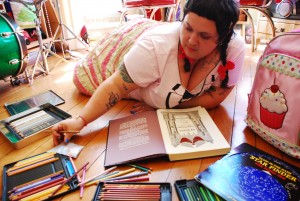I considered including a section about riot grrrl in Oy Oy Oy Gevalt! Jews and Punk, but it didn’t work out. Riot grrrl was a feminist punk movement that sprung out of Washington State in the early 1990s. I certainly featured female punks (some very prominently) in every chapter of my book. I mentioned the riot grrrl background of Shondes singer Louisa Solomon, included a quote about riot grrrl regarding Never Mind the Goldbergs, and discussed a Shiragirl song released by Play-a-Grrrl.
I did not address Jewish connections to riot grrrl artists directly because, based on my research, it did not seem warranted. It did not belong in the chapter about prominent Jews in punk, because even the prominent Jews in riot grrrl did not seem to make a point of their Jewishness. It did not belong in the chapter about punk musicians that put their Jewish identity front and center. I had to be selective with whom I reached out to for interviews, and if I didn’t have enough material to formulate decent interview questions, there was no point in e-mailing a prominent musician and saying, “I’ve listened to your music and talked to a few Jews who are quite knowledgeable about riot grrrl and read interviews and books, and I don’t hear you discussing your Jewishness. But is there anything I should know about you for my book with my specific focus?” That’s particularly true considering that prominent musicians typically had publicists and were less interested in being interviewed for my book anyway.
Steven Lee Beeber devoted two pages to riot grrrl in The Heebie-Jeebies at CBGB’s: A Secret History of Jewish Punk, and after interviewing Beeber, I decided not to move forward with the artists he discussed. He talked about Courtney Love (who is Jewish on her mother’s side but who, to the best of my knowledge, has never addressed her Jewishness in her music) and Hole, which, as he put it, was “on the fringes of the actual Riot Grrrl scene.” He talked about Bikini Kill singer Kathleen Hanna, “who some allege is Jewish though she denies it.” The band Bratmobile also came up in conversation with Beeber and others. All of these seemed like dead ends in terms of the qualifying criteria discussed above.
The Heebie-Jeebies at CBGB’s also mentioned Sleater-Kinney, which is often associated with riot grrrl even if labels can be limiting. The trio included two Jews, Carrie Brownstein and Janet Weiss. It wasn’t until October 2015, after my manuscript was due, that Brownstein’s memoir was published. (I was unsuccessful in my attempt to get an advance copy!) In Hunger Makes Me a Modern Girl, Brownstein only brought up Jewishness twice, and it was not a significant part of her identity. First, Brownstein wrote, “My parents, both raised Jewish in Chicago, were quick to adopt the religion of Christmas, though I should acknowledge the transitional years wherein we awoke to scattered presents under a menorah. Poor Santa, arriving during the night with nothing to choose from but that menorah and a houseplant.” Second, Brownstein wrote about meeting up with the Rosenblum family, friends of her grandparents, while on tour in Australia and noticing Fela Rosenblum’s “arm bearing her Holocaust tattoo.” Essentially, Brownstein justified her exclusion from my book.
Multiple sources pointed me in the direction of Nomy Lamm, a self-described “bad ass, fat ass Jew dyke amputee, writer, performance artist, and activist.” Lamm came out of the ’90s riot grrrl movement, but she didn’t qualify for either of the chapters described above. I was curious to watch the supposed “Nomy Lamm—Connections Between Punk Rock and Judaism” extra advertised for the Young, Jewish, and Left DVD, but the actual Lamm extra included on the DVD did not discuss punk. After more than a year of being in touch with the filmmakers, I finally got to watch the raw footage of her interview, from approximately 2003, last week. (Thank you to the filmmakers and Lamm for permitting me to quote from it!)
Lamm discussed how her Jewish background helped shape her identity as an outsider, which she related to punk and her other identities. She also talked about bringing a punk outlook to her Jewish practice. “Because of my history with punk rock and writing zines … the idea that we can do what we want to do ourselves and we don’t have to go through the proper channels to be able to create it, I bring that attitude to Judaism also,” she said. Regarding bringing a punk attitude to Judaism, she continued:
It’s all ours. We can do whatever we want with whatever we have. And there’s not these sanctified rules around things. There might be and there might have been reasons for having those rules … but I don’t look at it from a perspective of “This is what I’m commanded to do and have to do or else I’m not being a good Jew.” I take it as, if I’m going to be a good Jew, which is being a good “me,” which is everything that I am, then I’m going to take what I have and see what I can work out of it with my own brain and my own consciousness and my own community.


No Comments